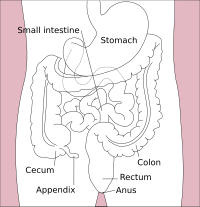
Photo from wikipedia
Objective: The incidence and significance of pneumatosis intestinalis (PI) in children with a diagnosis of intestinal failure is not well understood. The aim of this study was to identify clinical… Click to show full abstract
Objective: The incidence and significance of pneumatosis intestinalis (PI) in children with a diagnosis of intestinal failure is not well understood. The aim of this study was to identify clinical and anatomical factors associated with the imaging findings of PI in patients with intestinal failure. Methods: We performed a retrospective review of all children with a diagnosis of intestinal failure at Children’s Hospital Colorado between January 2019 and April 2022. Patients were stratified and compared based on the incidence of PI on abdominal imaging. Differences were compared using 2-sample Wilcoxon tests, chi-square, or Fisher exact tests. Results: There were 111 patients identified with a diagnosis of intestinal failure and 30.6% (34) developed at least 1 instance of PI. There were no differences in etiology of intestinal failure or anatomy between those who developed PI and those who did not. Patients who developed PI, were less likely to be on total parental nutrition (60.6% vs 98.6%, P < 0.001) and more likely to be receiving any form of enteral feeds (87.9% vs 66.2%, P = 0.035) or tube feeds (75.8% vs 44.2%, P = 0.0045). Of the children with PI, 30.3% (10) were undergoing an enteral feed advancement at time of PI development. Three patients with PI underwent laparotomy for PI treatment, 2 of which were negative laparotomies. Conclusions: The development of PI in children with intestinal failure is likely a benign finding. It is associated with enteral feeding and may be due to increased intestinal stress.
Journal Title: Journal of Pediatric Gastroenterology and Nutrition
Year Published: 2023
Link to full text (if available)
Share on Social Media: Sign Up to like & get
recommendations!